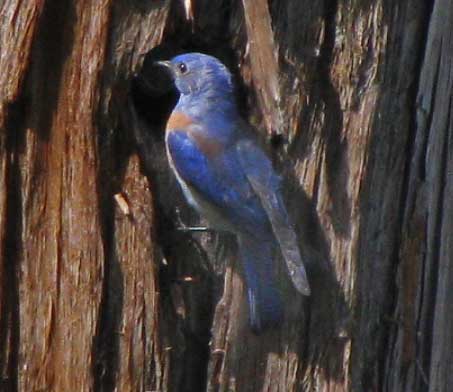Excerpts from Jim Conrad's
Naturalist Newsletter
from the June 27, 2009 Newsletter, issued from the Siskiyou Mountains west of Grants Pass, Oregon:
BLUEBIRD NEST IN A SNAG
During last weekend's backpacking trip as I descended Onion Mountain with Shan Creek Valley opening beside me a certain blue speck streaked across my peripheral vision. The flight was so smooth, a gliding swoop, that without looking I knew it was a bluebird, but which one? Of North American bluebirds there are three: The Eastern, Western and Mountain. Out here we can look for Western and Mountain Bluebirds.
The bluebird landed about 20 feet up an old, weather- ravaged, Incense Cedar snag and since the slope between the snag and my trail descended at about 45°, the bird stood at eye level some 20 feet away. It was a male visiting his nest in an old woodpecker hole. Nestlings peeped loudly but papa didn't stay more than a couple of seconds. You can see his second visit, also lasting no more than two or three seconds, below:

He's a Western Bluebird, SIALIA MEXICANA. Westerns differ from Easterns in that the rusty color of the Westerns' bellies extends across their "shoulders" onto their upper back, while Easterns have all-blue backs. Also the male Western's throat is blue while the Eastern male's throat is rusty. Both Eastern and Western differ from Mountain Bluebirds by being darker blue than the Mountain.
Through several nest visits I admired the bird's diligence and dedication to the young, and ability to return with food so fast. A female flew by but didn't land; maybe she was more nervous about my presence than the male.
Also I reflected on the male's devotion in terms of recent genetic research that showed that 45% of Western Bluebird nests studied held nestlings that had not been fathered by the male attending the nest. Some 19% of all young in all nests had come from fathers other than the male defending the nest's territory. Since the mates of some species tend to be "true" to one another while pairs in other species are even more promiscuous, I deduce nothing here relevant to human behavior. It's simply that in the Western Bluebird's case the strategy is most adaptive, so it's practiced. Also, Nature loves diversity, and this is one manifestation of that.
I've read that sometimes Western Bluebirds have helpers at their nest, presumably older offspring whose own nests have failed. Western Bluebird nests have even been documented being defended and supplied with food by Violet-green Swallows, who belong to an entirely different bird family.
If you're particularly interested in birdnests you might enjoy visiting Cornell University's NestCam page at http://www.birds.cornell.edu/birdhouse/nestboxcam/.
There you can watch streaming video of nestlings being fed and cared for, and even help researchers by reviewing archived nestcam photos to see which in the huge archive need the specialists' attention.
from the January 19, 2007 Newsletter, issued from Sierra Gorda Biosphere Reserve, QUERÉTARO, MÉXICO:
WESTERN BLUEBIRDS
Around the sunlight-dazzled, windswept, ridge-crest town of Cuatro Palos, all afternoon, Western Bluebirds glided from one maguey plant to another. In the intense light they looked all-black, but sometimes when one turned just right you could catch a glimpse of chestnut on the chest and sometimes even see a glimmer of blue. However, it wasn't necessary to see the birds' colors to know them, for bluebirds have that special, low-swooping, soft-touch manner of flying from one perch to another, or from a perch onto the ground for a quick snack, and there among the heights their flight seemed even more distinctive.
Western Bluebirds look a lot like their Eastern counterparts, just with less rustiness on their chests, and their throats are blue, not rusty as with the Easterns. Up north the two species occupy different sides of the continent but down here the species mingle in the uplands, occupying similar habitats. It's interesting that both species avoid the hot, humid lowlands.
At this time of year the birds' hormonal levels are low so they're not territorial and often appear in small groups. Both the Eastern and Western species are permanent residents here, though during the winter their numbers may be augmented by migrants from the north. The Westerns seem most common here, however. Well, their scientific name is SIALIA MEXICANA, after all.
The Mountain Bluebird, with a paler, sky-blue color, also occurs in the northern Mexican uplands, but only as a winter migrant.